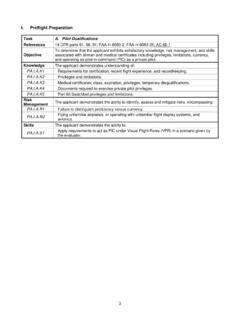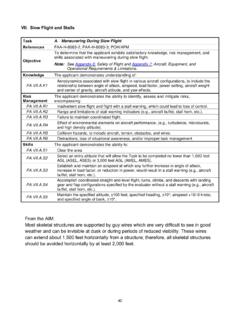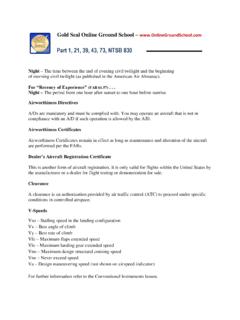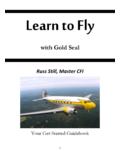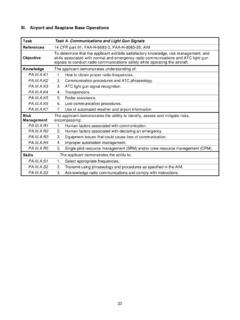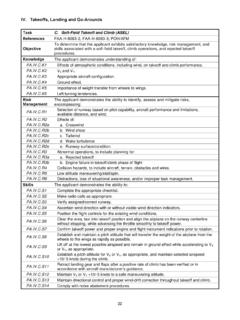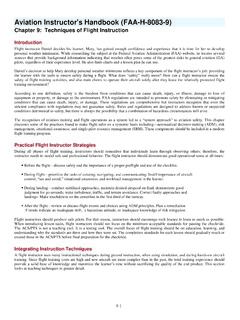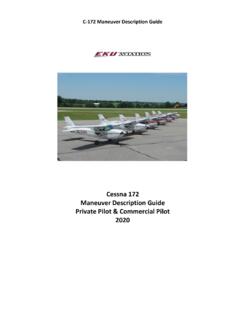Transcription of FAA-H-8083-15B, Instrument Flying Handbook
1 InstrumentFlying Departmentof TransportationFEDERAL aviation ADMINISTRATIONFAA-H-808 Chapter 10: IFR FlightI chapter is a discussion of conducting a flight under Instrument flight rules (IFR). It also explains the sources for flight planning, the conditions associated with Instrument flight, and the procedures used for each phase of IFR flight: departure, en route, and approach. The chapter concludes with an example of an IFR flight that applies many of the procedures discussed in the FlightChapter 1010-2 Sources of Flight Planning InformationThe following resources are available for a pilot planning a flight conducted under Aeronautical Navigation Products (AeroNav Products) Group publications: IFR en route charts Area charts United States Terminal Procedures Publications (TPP) The federal aviation administration (FAA) publications.
2 Aeronautical Information Manual (AIM) Airport/Facility Directory (A/FD) Notices to Airmen Publication (NTAP) for flight planning in the National Airspace System (NAS)Pilots should also consult the Pilot s Operating Handbook /Airplane Flight Manual (POH/AFM) for flight planning information pertinent to the aircraft to be review of the contents of all the listed publications helps determine which material should be referenced for each flight. As a pilot becomes more familiar with these publications, the flight planning process becomes quicker and Information Manual (AIM)The AIM provides the aviation community with basic flight information and air traffic control (ATC) procedures used in the United States NAS.
3 An international version called the Aeronautical Information Publication contains parallel information, as well as specific information on the international airports used by the international Directory (A/FD)The A/FD contains information on airports, communications, and navigation aids (NAVAIDs) pertinent to IFR flight. It also includes very-high frequency omnidirectional range (VOR) receiver checkpoints, flight service station (FSS), weather service telephone numbers, and air route traffic control center (ARTCC) frequencies.
4 Various special notices essential to flight are also included, such as land-and-hold-short operations (LAHSO) data, the civil use of military fields, continuous power facilities, and special flight the major terminal and en route environments, preferred routes have been established to guide pilots in planning their routes of flight, to minimize route changes, and to aid in the orderly management of air traffic using the federal airways. The A/FD lists both high and low altitude preferred to Airmen Publication (NTAP)The NTAP is a publication containing current Notices to Airmen (NOTAMs) that are essential to the safety of flight, as well as supplemental data affecting the other operational publications listed.
5 It also includes current Flight Data Center (FDC) NOTAMs, which are regulatory in nature, issued to establish restrictions to flight or to amend charts or published Instrument approach procedures (IAPs).POH/AFMThe POH/AFM contain operating limitations, performance, normal and emergency procedures, and a variety of other operational information for the respective aircraft. Aircraft manufacturers have done considerable testing to gather and substantiate the information in the aircraft manual. Pilots should refer to it for information relevant to a proposed Flight PlanAs specified in Title 14 of the Code of federal Regulations (14 CFR) part 91, no person may operate an aircraft in controlled airspace under IFR unless that person has filed an IFR flight plan.
6 Flight plans may be submitted to the nearest FSS or air traffic control tower (ATCT) either in person, by telephone (1-800-WX-BRIEF), by computer (using the direct user access terminal system (DUATS)), or by radio if no other means are available. Pilots should file IFR flight plans at least 30 minutes prior to estimated time of departure to preclude possible delay in receiving a departure clearance from ATC. The AIM provides guidance for completing and filing FAA Form 7233-1, Flight Plan. These forms are available at flight service stations (FSSs) and are generally found in flight planning rooms at airport terminal buildings.
7 [Figure 10-1]Filing in FlightIFR flight plans may be filed from the air under various conditions, including:1. A flight outside controlled airspace before proceeding into IFR conditions in controlled A visual flight rules (VFR) flight expecting IFR weather conditions en route in controlled either of these situations, the flight plan may be filed with the nearest FSS or directly with the ARTCC. A pilot who files with the FSS submits the information normally entered during preflight filing, except for point of departure, together with present position and altitude.
8 FSS then relays this information to the ARTCC. The ARTCC then clears the pilot from present position or from a specified navigation 10-1. Flight plan from. Figure 10-1. Flight plan pilot who files directly with the ARTCC reports present position and altitude, and submits only the flight plan information normally relayed from the FSS to the ARTCC. Be aware that traffic saturation frequently prevents ARTCC personnel from accepting flight plans by radio. In such cases, a pilot is advised to contact the nearest FSS to file the flight IFR Flight PlansAn IFR flight plan may be cancelled any time a pilot is operating in VFR conditions outside Class A airspace by stating cancel my IFR flight plan to the controller or air-to-ground station.
9 After cancelling an IFR flight plan, the pilot should change to the appropriate air-to-ground frequency, transponder code as directed, and VFR altitude/flight separation and information services (including radar services, where applicable) are discontinued when an IFR flight plan is cancelled. If VFR radar advisory service is desired, a pilot must specifically request it. Be aware that other procedures may apply when cancelling an IFR flight plan within areas such as Class C or Class B operating on an IFR flight plan to an airport with an operating control tower, a flight plan is cancelled automatically upon landing.
10 If operating on an IFR flight plan to an airport without an operating control tower, the pilot is responsible for cancelling the flight plan. This can be done by telephone after landing if there is no operating FSS or other means of direct communications with ATC. When there is no FSS or air-to-ground communications are not possible below a certain altitude, a pilot may cancel an IFR flight plan while still airborne and able to communicate with ATC by radio. If using this procedure, be certain the remainder of the flight can be conducted under VFR.
